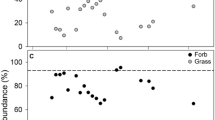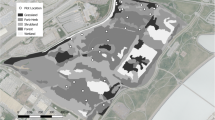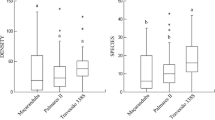Abstract
Re-vegetation plays a fundamental role for erosion control and plant recovery in lands affected by gully erosion. Bioengineered practices facilitate the gullies rehabilitation. Objectives of the research were: 1) Identify taxonomically the pioneer vegetation on each gully section; 2) Characterize vegetation distribution preferences and 3) Assess structural/ functional traits to recognize erosion control key species. Bioengineering was applied in a watershed belonging to Sierra Madre del Sur, at Oaxaca, Mexico, on eight gullies, with local support and minimal investment. “La Mixteca” is a poor ecological and socio-economic region, comparable to other regions of the world. The Initial Floristic Composition (IFC) inventory is the baseline of the successional process. The transect method was used to determine the colonization of species. Cover abundance of registered species was estimated using the semi-quantitative scale of Braun-Blanquet. This procedure was repeated in five different positions (floor, hillslopes and tops), in the cross section of the gully. Through correspondence analysis and clustering, the distribution of species was analyzed. Adequate responses were obtained in soil retention (quantity) and plant cover (existence and diversity); as measurable indicators of the bioengeneering works efficiency. Occupation of soil by native species from the Tropical Deciduous Forest was favored using live barriers. We detected species guilds with spatial distribution preferences in the gullies cross section. Plant cover characterization includes: native colonizer species, herbaceous, shrubby and trees of the forest community bordering the gully area, with cover abundance and structural/functional traits, useful to protect degraded areas. This spatial occupation process of plants responds to a secondary succession in gullies, where the proposed IFC model is correctly represented through bioengineering. Natural establishment of plants was successful by traits of species such as extensive root system and sexual/vegetative reproduction.
Similar content being viewed by others
References
Alcaraz–Ariza FJ (2013) Geobotany. 13th Theme. Vegetal succession (Sindinamics). Creative Commons License https://doi.org/creativecommons.org/licenses/by-nc/3.0/deed.es_CL; https://doi.org/www.um.es/docencia/geobotanica/ficheros/tema13.pdf (Accessed on 23 May 2017). (In Spanish)
Borrini–Feyerabend G, Farvar MT, Nguinguiri JC, Ndangang VA (2007). Comanagement of Natural Resources: Organizing, Negotiating and Learning–by–Doing. GTZ and IUCN, Kasparek Verlag, Heidelberg (Germany). https://doi.org/conservationdevelopment.net/rsFiles/Datei/CoManagement_English_Auflage2.pdf (Accessed on 5 March 2018)
Braun–Blanquet J (1979) Phytosociology. Basis for vegetal communities study. First Edition. Blume, Madrid. p 820. (In Spanish)
Bravo EM, Nieuwkoop M, Contreras JR, et al. (1993) Conservation plowing potentiality in Oaxaca (Mexico) Mixteca Region. INIFAP, Mexico. p 50. (In Spanish)
Burylo M, Rey F, Delcros P (2007) Abiotic and biotic factors influencing the early stages of vegetation colonization in restored marly gullies (Southern Alps, France). Ecological Engineering 30: 231–239. https://doi.org/10.1016/j.ecoleng.2007.01.004
Burylo M, Rey F, Bochet E, et al. (2012) Plant functional traits and species ability for sediment retention during concentrated flow erosion. Plant and Soil 353: 35–144. https://doi.org/10.1007/s11104-011-1017-2
Burylo M, Dutoit T, Rey F (2014) Species traits as practical tools for ecological restoration of Marly Eroded Lands. Restoration Ecology 22: 633–640. https://doi.org/10.1111/rec.12113
Calderón G de R, Rzedowski J, collaborators (2005) Phanerogams flora in the Valley of Mexico. Ecology Institute (INECOL) and the National Commission for the Knowledge and Use of Biodiversity (CONABIO). Patzcuaro, Mich. Mexico. (Digital Edition: INECOL 2010). (In Spanish) https://doi.org/www.biodiversidad.gob.mx/publicaciones/librosDig/pdf/Flora_del_Valle_de_Mx1.pdf
Camacho F (2011) Proposals for a restoration program in the forest of Santa Maria Yavesia, Oaxaca, Mexico. PS 67–162, 96 ESA Annual Meeting Austin Texas. Available online at: https://doi.org/eco.confex.com/eco/2007/webprogram/Paper3874.html (Accessed on 09 June 2017)
Cantón C Y (1999) Hydrological and geomorphological effects of vegetation cover and soil properties on a gullied landscape (Doctorate Dissertation) Almeria University. Almeria, Spain. Available online at: https://doi.org/www.diegomarin.net/ual/es/406-efectos-hidrologicos-y-geomorfologicos-de-la-cubierta-ypropiedades-del-suelo-en-paisajes-de-carcavas-9788482404523.html (Accessed on 26 May 2018) (In Spanish)
Cavaillé P, Ducasse L, Breton V, et al. (2015) Functional and taxonomic plant diversity for riverbank protection works: Bioengineering techniques close to natural banks and beyond hard engineering. Journal of Environmental Management 151: 65–75.
Contreras–Hinojosa JR, Volke–Haller V, Oropeza–Mota JL, et al. (2003) Current status and causes for rangeland degradation in Yanhuitlan, Oaxaca (Mexico) Municipality. Terra Latino American 21: 427–435. Available online at: https://doi.org/www.redalyc.org/pdf/573/57311097001.pdf (Accessed on 10 May 2017) (In Spanish)
Contreras–Hinojosa JR, Volke–Haller V, Oropeza–Mota JL, et al. (2005) Decreasing maize yield due to soil erosion in Yanhuitlan, Oaxaca (Mexico). Terra Latino American 23:399–408. Available online at: https://doi.org/www.redalyc.org/pdf/573/57311101012.pdf (Accessed on 03 November 2017) (In Spanish)
Costa PC, Pinto R, Mohan C, et al. (2013) Guidelines for Establishing Co–Management of Natural Resources in Timor–Leste. USAID Project Number: GCP LWA Award # LAG–A–00–99–00048–00. Conservation International for the Timor–Leste National Coordinating Committee. Coral Triangle Initiative on Coral Reefs, Fisheries and Food Security (CTICFF). Jakarta, Indonesia. Available online at: https://doi.org/www.conservation.org/publications/Documents/CI_Coral-Triangle-Initiative_CoManagement-of-Natural-Resources.pdf (Accessed on 24 February 2018)
Cruz CE (1992) Community rangelands in Tiltepec: A typical case of environmental degradation in Mixteca Alta Region (Oaxaca, Mexico). (Masters Dissertation). College of Postgraduates (COLPOS). Mexico.p 213. (In Spanish)
Cruz CE (2005) Morphological Variability and Seed Dormancy of Amelanchier (Rosaceae) Grown in Oaxaca, Mexico. Ph.D. Dissertation. Oregon State University. USA. p 200. https://doi.org/ir.library.oregonstate.edu/concern/graduate_thesis_or_dissertations/g158bk703
Cruz CE, Contreras HJR, Espinosa PH, et al. (2013) Shrubby species for embankment stabilization on road construction. National Institute of Forestry, Agriculture and Livestock Research (INIFAP–CIRPAS) Technical Bulletin 71. Zacatepec Experimental Campus (Morelos, Mexico). p 35. https://doi.org/biblioteca.inifap.gob.mx:8080/xmlui/bitstream/handle/123456789/3996/CIRPAS_01020846100046514ok.pdf?sequence=1 (In Spanish) De
Baets S, Poesen J, Reubens B, et al. (2009) Methodological framework to select plant species for controlling rill and gully erosion: application to a Mediterranean ecosystem. Earth Surface Processes and Landforms 34: 1374–1392.
Desta L, Adugna B (2012) A field guide on gully prevention and control. Nile Basin Initiative. Ethiopia. https://doi.org/www.bebuffered.com/downloads/ManualonGullyTreatment_TOTFinal_ENTRO_TBIWRDP.pdf (Accessed on 25 November 2017)
Duvauchelle D (2009) Plant fact sheet for hop bush (Dodonaea viscosa (L.) Jacq. USDA–Natural Resources Conservation Service, Hawaii Plant Materials Center, Hoolehua. https://doi.org/plants.usda.gov/factsheet/pdf/fs_dovi.pdf (Accessed on 13 September 2016).
Egler FE (1954) Vegetation Science Concepts I. Initial floristic composition, a factor in old–field vegetation development. Vegetatio Acta Geobotany 4: 412–417. https://doi.org/10.1007/BF00275587
Erktan A, Rey F (2013) Linking sediment trapping efficiency with morphological traits of Salix tiller barriers on marly gully floors under ecological rehabilitation. Ecological Engineering 51: 212–220.
Erktan A, Cécillon L, Roose E, et al. (2013) Morphological diversity of plant barriers does not increase sediment retention in eroded marly gullies under ecological restoration. Plant and Soil 370: 653–669.
Garcia E, National Commission for the Knowledge and Use of Biodiversity (CONABIO) (1998) Climate Map 1:1 000 000. Köppen Classification Modified by E. Garcia. In: Geographic Information Metadata Catalogue. National Commission for the Knowledge and Use of Biodiversity (CONABIO). Mexico. https://doi.org/www.conabio.gob.mx/informacion/metadata/gis/clima1mgw.xml?_httpcache=yes&_xsl=/db/metadata/xsl/fgdc_html.xsl&_indent=no (Accessed on 18 May 2018). (In Spanish)
Gómez–Aparicio L (2009) The role of plant interactions in the restoration of degraded ecosystems: a meta–analysis across life–forms and ecosystems. Journal of Ecology 97: 1202–1214. https://doi.org/10.1111/j.1365-2745.2009.01573.x
Granados–Victorino RL, Sánchez–González A, Martínez–Cabrera D, et al. (2017) Structure and arboreal composition of three successional stages of medium subperennifolia forest of the municipality of Huautla, Hidalgo, Mexico. Mexican Journal of Biodiversity 88: 122–135. (In Spanish)
Grether R, Martínez–Bernal A, Luckow M, et al. (2006) Mimosaceae. Tehuacan–Cuicatlan Valley Flora (Oaxaca, Mexico). Booklet 44. Biology Institute, National Autonomous University of Mexico (UNAM). p115. (In Spanish)
Guizar–Nolasco E, Granados–Sánchez D, Castañeda–Mendoza A (2010) Flora and vegetation in the South of Mixteca Region (Puebla, Mexico). Chapingo Journal. Forestry and Environmental Sciences Series. 16: 95–118. (In Spanish)
Hardle W, Simar L (2007) Applied Multivariate Statistical Analysis. Sixth Ed. Springer, Berlin. p 458.
INEGI (2007) Edaphological vector data, scale 1:250 000 II Series (National Continuous). Geography and Statistics National Institute (INEGI), Mexico. Available online at: https://doi.org/www.inegi.org.mx/geo/contenidos/recnat/edafologia/vectorial_serieii.aspx (Accessed on 23 June 2016). (In Spanish)
Leff E, Carabias J, Batis AI (1990) Natural resources, technology and culture. Studies and experiences for alternative development. Center for Interdisciplinary Research in Humanities Seminar Series, No. 1. UNAM, Mexico.
McCune B, Grace JB (2002) Analysis of Ecological Communities. MjM Software, Gleneden Beach, Gleneden Beach, Oregon, USA. p 284.
McCune B, Mefford MJ (2011) PC–ORD for Windows. Multivariate Analysis of Ecological Data. Version 6.0. MjM Software, Gleneden Beach, Oregon, USA.
Peck JE (2010) Multivariate analysis for community ecologists: step–bye–step using PC–ORD. MjM Software, Gleneden Beach, Oregon, USA.
Petrone A, Preti F (2010) Soil bioengineering for risk mitigation and environmental restoration in a humid tropical area. Hydrology and Earth System Sciences 14: 239–250. https://doi.org/10.5194/hess-14-239-2010
Poesen J, Nachtergaele J, Verstraeten G, et al. (2003) Gully erosion and environmental change: importance and research needs. Catena 50: 91–133. https://doi.org/10.1016/S0341-8162(02)00143-1
Pyšek P, Chocholouskova Z, Pyšek A, et al. (2004) Trends in species diversity and composition of urban vegetation over three decades. Journal of Vegetation Science 15: 781–788.
Reubens B, Poesen J, Danjon F, et al. (2007). The role of fine and coarse roots in shallow slope stability and soil erosion control with a focus on root system architecture: a review. Trees 21: 385–402. https://doi.org/10.1007/s00468-007-0132-4
Rey F, Burylo M (2014) Can bioengineering structures made of willow cuttings trap sediment in eroded marly gullies in a Mediterranean mountainous climate? Geomorphology 204: 564–572.
Rey F, Isselin–Nondedeu F, Bédécarrats A (2007) Vegetation dynamics on sediment deposits upstream of bioengineering works in mountainous marly gullies in a Mediterranean climate (Southern Alps, France). In: Stokes A, Spanos I, Norris JE, Cammeraat E (eds.), Eco–and Ground Bio–Engineering: The Use of Vegetation to Improve Slope Stability. Developments in Plant and Soil Sciences Vol. 103. Springer, Dordrecht. pp 297–307.
Sánchez–Castillo L, Kubota T, Cantú–Silva I, et al. (2017) Comparison of the root mechanical properties of three native Mexican tree species for soil bioengineering practices. Botanical Sciences 95(2): 1–11. https://doi.org/10.17129/botsci.802
SER Science & Policy Working Group (2002) The SER Primer on Ecological Restoration, Society for Ecological Restoration (SER) (available from: https://doi.org/www.ser.org
SMN (2010) Climate Information by States. Oaxaca (Mexico) San Mateo Etlatongo Station, SMN 20265. Available online at: https://doi.org/smn.cna.gob.mx/es/informacion-climatologica-verestado?estado=oax (Accessed on 18 May 2018). (In Spanish)
Valentin C, Poesen JL, Li Y (2005) Gully erosion: impacts, factors and control. Catena 63: 132–153. https://doi.org/10.1016/j.catena.2005.06.001 Van
Breugel M, Bongers F, Martínez–Ramos M (2007) Species dynamics during early secondary forest succession: recruitment, mortality and species turnover. Biotropica 39: 610–619.
Villaseñor JL (2004) Vascular plants genera in the Flora of Mexico. Botanical Society of Mexico Bulletin 75: 105–135. Available online at: https://doi.org/www.redalyc.org/articulo.oa?id=57707506 (Accessed on 18 February 2016). (In Spanish)
White H, Lal R (2010) Principles of Soil Conservation and Management. Springer, New York. p 107.
Wischmeier WH, Smith DD (1978) Predicting rainfall erosion losses. Agricultural Handbook 537. USDA, Science and Education Administration, Washington. Available online at: https://doi.org/naldc.nal.usda.gov/download/CAT79706928/PDF (Accessed on 28 May 2018)
Acknowledgements
We thank to World Wildlife Fund (WWF) for providing financial support for the conduction of the research through Oaxaca Community Foundation. To the population of Santa María Tiltepec, Oaxaca, Mexico, for the field walks and for helping to the field works in the mountains; to Donaldo Ríos-Berber and Erasmo Rubio-Granados for the technical support; Héctor Flores-Magdaleno, Víctor Gordillo and Moisés Venegas who drove a high resolution unmanned aerial vehicle, and Mario Luna-Cavazos for the advice on the handling of statistical information. Ana Rita Roman-Jimenez collaborated on the Spanish to English translation of this paper. Finally, the National Council for Science and Technology supported the first author through grant for two years.
Author information
Authors and Affiliations
Corresponding author
Rights and permissions
About this article
Cite this article
Lira-Caballero, V.G., Martínez-Menez, M.R., Romero-Manzanares, A. et al. Initial floristic composition of rehabilitated gullies through bioengineering in the Mixteca Region, Sierra Madre del Sur, Mexico. J. Mt. Sci. 15, 2120–2135 (2018). https://doi.org/10.1007/s11629-018-4899-0
Received:
Revised:
Accepted:
Published:
Issue Date:
DOI: https://doi.org/10.1007/s11629-018-4899-0




